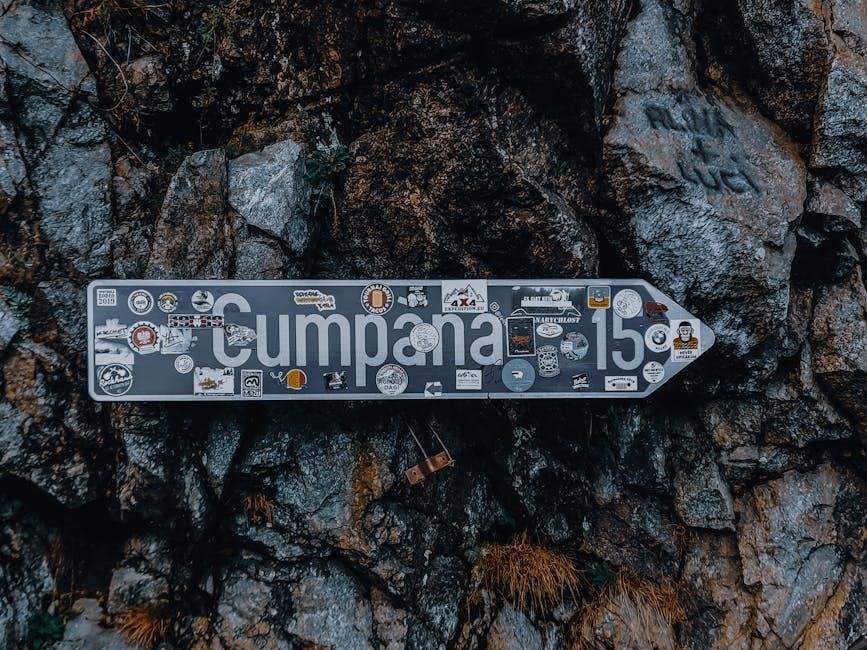
Ways of the World: A Brief Global History by Robert W. Strayer and Eric W. Nelson is a renowned textbook designed for world history courses. It emphasizes big-picture thinking, exploring significant historical trends and themes. The book is published by Bedford/St. Martins and is widely adopted for its concise and global approach, making it ideal for both undergraduate and AP World History programs.
1.1 Overview of the Textbook
Ways of the World: A Brief Global History by Robert W. Strayer and Eric W. Nelson is a concise and innovative textbook designed for world history courses. It focuses on the “big picture” of history, emphasizing significant trends, themes, and developments that have shaped the world. The textbook is structured chronologically, covering the entire sweep of human history from the earliest times to the present. Its global approach encourages students to think critically about connections, comparisons, and changes across time and regions. With a clear and engaging narrative, the book is tailored for students at various educational levels, including AP and college courses. Its availability in both print and digital formats, including PDF, makes it accessible for diverse learning needs.
1.2 Authors and Publication Details
Ways of the World: A Brief Global History is authored by Robert W. Strayer and Eric W. Nelson. Robert W. Strayer, a renowned historian, specializes in world history and has contributed significantly to its pedagogy. Eric W. Nelson brings expertise in global studies, enhancing the textbook’s comprehensive approach. Published by Bedford/St. Martins, the first edition appeared in 2013, with subsequent editions refining its content and structure. The textbook is widely recognized for its clarity and global perspective, making it a preferred choice for educators. It is available in both print and digital formats, including PDF, ensuring accessibility for students and instructors worldwide.
1;3 Key Features of the Textbook
Ways of the World: A Brief Global History stands out for its emphasis on the “big picture” of world history, focusing on broad trends and themes rather than detailed events. It employs a thematic approach, encouraging students to think critically about connection, comparison, and change over time. The textbook integrates primary sources and visual materials to enhance learning; Its concise structure and global perspective make it ideal for world history survey courses. The inclusion of digital resources, including a PDF version, ensures accessibility and flexibility for modern students. Additionally, supplementary materials like online platforms and study guides further support student engagement and understanding.

Historical Context and Structure
Ways of the World is a concise, globally oriented textbook by Robert W. Strayer and Eric W. Nelson, focusing on significant historical trends and themes, available in PDF format for easy access.
2.1 Chronological Organization
Ways of the World: A Brief Global History is structured chronologically, guiding students through major time periods, from the emergence of human societies to the contemporary world. This approach helps students understand the progression of historical events and their interconnections. The textbook begins with the origins of humanity, proceeds through ancient civilizations, traverses the medieval and early modern periods, and concludes with modern global transformations. Each chapter is carefully divided to highlight key transitions and continuities, ensuring a clear and logical flow of historical narrative. This chronological framework allows students to build a robust timeline of world history, facilitating a deeper comprehension of global developments over time.
2.2 Thematic Approach
Ways of the World: A Brief Global History employs a thematic approach to explore overarching patterns and connections across time and regions. Key themes include connection, comparison, and change, which help students analyze how societies have interacted, diverged, and evolved. This framework encourages a deeper understanding of global dynamics, such as trade networks, cultural exchanges, and technological advancements. By integrating these themes, the textbook provides a cohesive narrative that highlights both unity and diversity in human experiences. This approach fosters critical thinking and skill development, enabling students to draw meaningful conclusions about the complexities of world history.
2.3 Regional and Global Perspectives
Ways of the World: A Brief Global History seamlessly integrates regional and global perspectives to provide a comprehensive understanding of historical developments. The textbook explores specific regions, such as Asia, Africa, Europe, and the Americas, while also highlighting global connections and interactions. By analyzing local histories within a broader framework, students gain insights into how regional dynamics have shaped global patterns. The inclusion of primary sources and case studies further enriches this approach, allowing for a nuanced exploration of cultural, economic, and political exchanges. This balanced perspective encourages students to think critically about the interplay between regional identities and global transformations, fostering a deeper appreciation for the complexity of world history.

Key Themes and Concepts

The textbook emphasizes the “big picture” of world history, focusing on themes like connection, comparison, and change. It explores historical trends, technology, and cultural exchanges.
3.1 The “Big Picture” of World History
The Ways of the World textbook focuses on the “big picture” of world history, emphasizing broad patterns and connections across time and regions. It encourages students to think globally, exploring how major historical developments like technological advancements, trade networks, and cultural exchanges have shaped societies. By highlighting these overarching themes, the textbook provides a framework for understanding the shared human experiences and divergent paths that have defined global history. This approach helps students see the world as an interconnected system, rather than isolated regions, fostering a deeper appreciation of historical complexity and continuity.
3.2 Themes of Connection, Comparison, and Change
The Ways of the World textbook emphasizes three core themes: connection, comparison, and change. These themes guide students in analyzing how societies have interacted, diverged, and evolved over time. By focusing on connections, the text highlights global exchanges of ideas, goods, and cultures, such as trade networks and technological diffusion. Comparison encourages students to identify similarities and differences across regions, fostering a deeper understanding of historical contexts. Change is explored through transformations like industrialization, political revolutions, and environmental shifts. Together, these themes provide a dynamic framework for understanding the complexity of global history and its relevance to contemporary issues.
3.3 The Role of Technology and Science
Technology and science are central to understanding global history in Ways of the World. The textbook highlights how technological advancements, such as the printing press and steam engine, drove significant societal changes. Scientific discoveries, like those in medicine and astronomy, reshaped human understanding and global interactions. The integration of primary sources illustrates how these developments influenced cultural, economic, and political transformations across regions. By emphasizing the role of innovation, the text underscores how technology and science have been catalysts for global connections and changes, shaping the modern world. This focus aligns with the book’s emphasis on big-picture trends, providing students with a clearer understanding of historical progress and its ongoing impact.

Target Audience and Educational Use
Ways of the World is designed for students and instructors in world history courses, including AP and higher education. Its concise approach and focus on historical trends make it ideal for fostering critical thinking and global understanding.
4.1 Designed for World History Courses
Ways of the World: A Brief Global History is specifically crafted for world history courses, offering a concise and engaging narrative. It emphasizes the “big picture” of historical trends, themes, and developments, making it ideal for undergraduate and AP-level instruction. The textbook is structured to help students understand global connections, comparisons, and changes over time. Its thematic approach encourages critical thinking and skill development, aligning with the goals of world history education. Additionally, the inclusion of primary sources and digital resources enhances its versatility for classroom use. This makes it a popular choice for educators seeking a balanced and comprehensive curriculum.
4.2 Suitability for AP World History
Ways of the World is highly recommended for AP World History courses due to its alignment with the College Board’s curriculum framework. The textbook focuses on the three key concepts of connection, comparison, and change, which are central to the AP course. It provides a global perspective, covering all time periods and regions required by the AP syllabus. The inclusion of primary sources and thematic chapters helps students develop analytical skills and prepare for the AP exam. Its concise format ensures comprehensive coverage without overwhelming students, making it an excellent resource for AP instructors and students aiming to succeed in the course.
4.3 Use in Higher Education
Ways of the World is widely adopted in higher education for its versatility in teaching world history. Its concise structure and focus on global themes make it ideal for undergraduate courses. The textbook aligns with curriculum goals, fostering critical thinking and historical analysis. Many universities integrate the PDF version into their digital libraries, providing easy access for students. Supplementary materials, such as primary sources and study guides, enhance its educational value. The textbook’s emphasis on comparison, connection, and change supports advanced learning objectives. Additionally, its availability in digital formats ensures accessibility for modern students. This makes it a preferred choice for professors designing world history programs at the university level.

Availability and Formats
Ways of the World is available in print and digital formats, including PDF versions for easy accessibility. Supplementary materials like study guides and primary sources enhance its educational value.
5.1 Print and Digital Versions
Ways of the World is available in both print and digital formats, offering flexibility for students and educators. The print version provides a traditional learning experience, while the digital edition, including PDFs, ensures accessibility on various devices. PDF versions can be found on platforms like Perlego and Google Drive, with some editions offering supplementary materials such as study guides and primary sources. A Value Edition is also available, providing an affordable option without compromising on content quality. These formats cater to diverse learning preferences, making the textbook a versatile resource for world history education.
5.2 PDF Availability and Access
Ways of the World is widely available in PDF format, offering convenient access for students and educators. The textbook can be downloaded from platforms like Google Drive, Perlego, and university digital libraries. Many institutions provide free access to the PDF version through their online portals, while others require subscription or purchase. Additionally, platforms such as annas-archive.org and Internet Archive host PDF copies, though some may have accessibility restrictions. The PDF format ensures compatibility across devices, allowing users to study seamlessly on computers, tablets, or smartphones. This accessibility makes the textbook a popular choice for both in-class and remote learning environments.
5.3 Supplementary Materials and Resources
Supplementary materials for Ways of the World enhance learning and teaching experiences. These include instructor manuals, study guides, and online resources accessible via Bedford/St. Martins’ platforms. The textbook is accompanied by a companion website offering lecture slides, primary sources, and test banks. Additionally, digital tools like Perlego provide integrated access to the textbook alongside study aids. PDF versions often include bookmarks and hyperlinks for easy navigation. Many universities and online platforms also offer supplementary PDF guides, such as chapter summaries and review questions, to support student engagement. These resources ensure a comprehensive and interactive approach to world history education, catering to diverse learning needs and preferences.

Content and Chapter Breakdown
Ways of the World is structured chronologically, covering global history from ancient times to the present. Chapters emphasize big-picture themes like connection, comparison, and change. The textbook integrates primary sources and is available in PDF format, offering easy navigation and access to historical content.
6.1 Volume and Edition Details
Ways of the World: A Brief Global History is available in multiple editions and volumes, catering to different educational needs. The Combined Volume covers the entire span of global history, while Volume 2 focuses on the period from 1200 to the present. Published by Bedford/St. Martins, the textbook has undergone several editions, with notable updates in 2013, 2015, and 2016. A second edition emerged in 2021, enhancing its alignment with AP World History standards. The Value Edition offers an affordable option without compromising content quality. Additionally, the PDF version of the textbook is widely accessible, ensuring convenience for digital learners. Each edition maintains the core focus on significant historical trends, themes, and developments, making it a versatile resource for both students and educators.
6.2 Chapter Structure and Topics
Ways of the World: A Brief Global History is structured chronologically, with chapters divided into broad time periods that emphasize significant historical developments. The textbook begins with the Big Bang and early human history, progressing through ancient civilizations, medieval societies, and modern global interactions. Each chapter focuses on key themes such as connection, comparison, and change, encouraging students to think critically about global patterns. Topics range from the rise of major religions and empires to the impact of technological advancements and environmental factors. The Combined Volume covers the entire sweep of global history, while Volume 2 concentrates on the period from 1200 to the present. This structure ensures a comprehensive yet concise exploration of world history, making it accessible for students and educators alike.
6.3 Integration of Primary Sources
Ways of the World: A Brief Global History seamlessly integrates primary sources to enrich students’ understanding of historical events and cultural perspectives. The textbook includes excerpts from legal codes, religious texts, letters, and other historical documents, providing firsthand insights into the experiences of people across time and place. These sources are carefully selected to align with the book’s emphasis on connection, comparison, and change. For example, the inclusion of the Cyrus Cylinder or the letters of Emperor Taizong highlights diverse governance strategies. The “Ways of the World with Sources” edition further expands this approach, offering a comprehensive collection of primary materials. This integration not only enhances critical thinking but also helps students engage directly with the voices of the past, fostering a deeper appreciation for global history. The digital versions of the textbook often include links to additional primary sources, making it a valuable resource for both students and educators.

Educational Impact and Reception
Ways of the World has been widely adopted in educational institutions for its clear structure and focus on significant historical themes. Its concise approach and integration of primary sources have made it a preferred choice for both students and educators, fostering a deeper understanding of global history while encouraging critical thinking and analysis.
7.1 Adoption in Educational Institutions
Ways of the World has seen widespread adoption in educational institutions worldwide, particularly in world history and AP courses. Its concise structure and thematic focus make it a preferred choice for educators. The textbook is frequently integrated into syllabi for its ability to highlight broad historical patterns and encourage critical thinking. Many universities and colleges have embraced it for its clarity and accessibility, with the PDF version being a popular choice for digital learning. Its adoption reflects its effectiveness in engaging students and fostering a deeper understanding of global history, making it a cornerstone of many history programs.
7.2 Reviews and Ratings
Ways of the World has received positive reviews for its engaging and concise approach to world history. Educators praise its focus on broad themes and its ability to connect historical events across regions. The textbook is highly rated for its clarity and effectiveness in preparing students for AP World History exams. Many reviewers highlight its accessible structure and the integration of primary sources, which enhances student engagement. The PDF version is particularly popular for its convenience and ease of access. Overall, the textbook is widely regarded as a valuable resource for teaching and learning world history, with high adoption rates and strong recommendations from both instructors and students.
7.3 Impact on Curriculum Design
Ways of the World has significantly influenced world history curriculum design by emphasizing thematic and comparative approaches. Its focus on big-picture trends encourages educators to adopt a more integrated and global perspective. The textbook’s structure, which blends chronological and thematic organization, has inspired many institutions to revise their syllabi to incorporate similar frameworks. Additionally, the inclusion of primary sources and digital resources has prompted schools to integrate more diverse materials into their courses. The textbook’s success in aligning with AP World History standards has further solidified its role in shaping modern curriculum design, making it a benchmark for educators worldwide. This impact reflects its ability to adapt to evolving educational needs while maintaining academic rigor and accessibility.

Digital Resources and Accessibility
Ways of the World offers extensive digital resources, including PDF versions, online platforms, and supplementary materials, enhancing accessibility for students and educators. Its digital format ensures flexibility and convenience, catering to diverse learning needs while maintaining academic excellence.
8.1 Online Platforms and Access
Ways of the World is accessible via various online platforms, including Perlego and MyHistoryClasses.com, offering students and educators convenient digital access. The textbook is available in PDF format, ensuring compatibility across devices. Supplementary materials, such as study guides and instructor manuals, are also accessible online, enhancing the learning experience. These platforms provide user-friendly interfaces, allowing seamless navigation and access to resources. Additionally, many educational institutions offer the textbook through their digital libraries, further expanding accessibility. The digital version supports flexible learning, catering to both individual and classroom needs. This accessibility ensures that students can engage with the material anytime, fostering a more dynamic and inclusive educational environment.
8.2 Digital Libraries and Sharing
Ways of the World is widely available in digital libraries, including those of universities and online platforms like Perlego. The PDF version can be accessed through these libraries, enabling easy sharing among students and educators. Many institutions provide free access to the textbook through their digital repositories, while platforms like Google Drive host shared folders containing the PDF. This accessibility facilitates collaborative learning and ensures that the material is readily available for academic use. Digital libraries also offer supplementary resources, enhancing the educational experience. The sharing of Ways of the World in digital formats promotes convenience and inclusivity, making it a preferred choice for modern education.
8.3 Accessibility Features
The Ways of the World textbook in PDF format offers several accessibility features to ensure inclusivity for all learners. The digital version is compatible with screen readers, making it accessible to visually impaired students. Additionally, the text allows for adjustable font sizes and readability adjustments, enhancing usability. Many educational institutions provide free access to the PDF through their digital libraries, ensuring that students with disabilities can easily access the material. Platforms like Perlego also offer unlimited access to the textbook, further promoting accessibility. These features make Ways of the World an inclusive resource for diverse learning needs, fostering an equitable educational environment.

Future of the Textbook
The future of Ways of the World includes updated editions, enhanced digital features, and expanded integration of technology for immersive learning experiences, ensuring continued relevance in education.
9.1 Updates and New Editions
Ways of the World is regularly updated to reflect the latest historical research and educational needs. The second edition, for instance, incorporates enhanced digital tools and primary sources, ensuring a comprehensive learning experience. New editions focus on refining the textbook’s global perspective, with a strong emphasis on themes like connection, comparison, and change. These updates aim to align the content with evolving curriculum standards and technological advancements in education. Additionally, PDF versions of the textbook are periodically revised to include new materials, making it a dynamic resource for both students and instructors. The commitment to continuous improvement ensures the textbook remains a leading choice for world history courses.
9.2 Emerging Trends in Digital Learning
Digital learning continues to transform education, with Ways of the World embracing these trends to enhance student engagement. The integration of online platforms and digital libraries allows seamless access to the textbook in PDF format, fostering flexibility in learning. Interactive elements, such as primary source analysis and multimedia resources, are increasingly incorporated to cater to diverse learning styles. Additionally, the rise of personalized learning tools enables students to explore historical content at their own pace. These advancements ensure that the textbook remains relevant and effective in a rapidly evolving educational landscape, providing students with a rich and dynamic learning experience that extends beyond traditional classroom settings.
9.3 The Role of Technology in Education
Technology plays a pivotal role in modern education, and Ways of the World leverages this to enrich learning experiences. Digital versions of the textbook, including PDF formats, are easily accessible, enabling students to study anytime and anywhere. Online platforms offer supplementary resources, such as interactive maps and primary sources, which deepen understanding of historical concepts. Moreover, technology facilitates collaboration through discussion forums and shared digital spaces, fostering a more engaged and connected learning community. By integrating cutting-edge tools, Ways of the World seamlessly adapts to the digital age, ensuring that students have the resources they need to succeed in an increasingly technology-driven world. This approach not only enhances accessibility but also supports innovative teaching methods that cater to the needs of today’s learners.